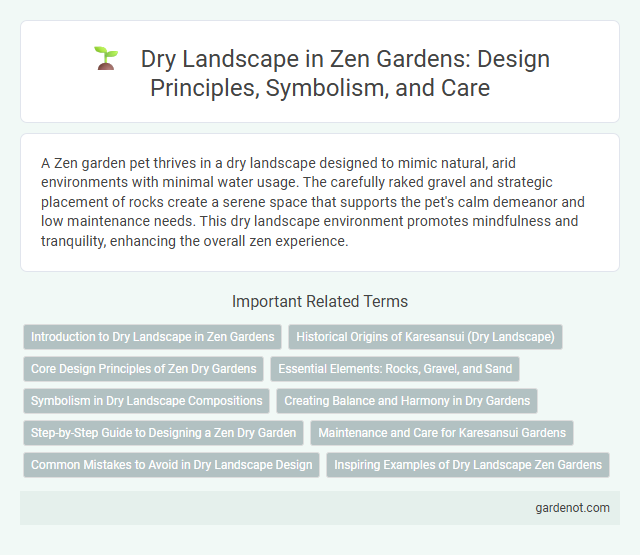A Zen garden pet thrives in a dry landscape designed to mimic natural, arid environments with minimal water usage. The carefully raked gravel and strategic placement of rocks create a serene space that supports the pet's calm demeanor and low maintenance needs. This dry landscape environment promotes mindfulness and tranquility, enhancing the overall zen experience.
Introduction to Dry Landscape in Zen Gardens
Dry landscape, or karesansui, is a traditional Japanese garden style that uses rocks, gravel, and sand to symbolize natural landscapes without the presence of water. Carefully raked gravel represents flowing water, while strategically placed stones mimic mountains or islands, creating a minimalist yet evocative scene. This art form emphasizes simplicity, balance, and meditation, fostering a tranquil environment for contemplation.
Historical Origins of Karesansui (Dry Landscape)
The origins of Karesansui, or dry landscape gardens, trace back to Japan's Muromachi period (1336-1573), where Zen Buddhist monks designed these minimalist gardens to evoke the essence of nature through carefully arranged rocks, gravel, and sand. These gardens symbolize concepts such as meditation, impermanence, and natural simplicity, reflecting Zen principles and serving as aids for contemplative practice. Influenced by Chinese landscape painting and Buddhist philosophy, Karesansui became an iconic cultural heritage representing spiritual harmony and artistic expression.
Core Design Principles of Zen Dry Gardens
Zen dry gardens, or karesansui, emphasize simplicity, asymmetry, and naturalness to evoke tranquility and contemplation. Key design principles include the careful arrangement of rocks, gravel, and sand to symbolize mountains, rivers, and islands without using water. Controlled raking patterns create rhythmic textures that enhance the garden's meditative atmosphere while maintaining balance and harmony.
Essential Elements: Rocks, Gravel, and Sand
Rocks, gravel, and sand are the essential elements of a Zen dry landscape garden, designed to evoke natural landscapes through minimalistic aesthetics. Carefully arranged rocks symbolize mountains or islands, while gravel and sand represent water or waves, raked into precise patterns that promote meditation and tranquility. This harmonious composition emphasizes simplicity, balance, and the subtle beauty found in nature's raw textures.
Symbolism in Dry Landscape Compositions
Dry landscape compositions in Zen gardens symbolize the essence of natural elements such as mountains and rivers through the strategic arrangement of rocks and gravel. The raked gravel represents flowing water, while stones suggest islands or mountain peaks, embodying harmony and tranquility. This symbolism encourages meditation and reflection on the impermanence and simplicity found in nature.
Creating Balance and Harmony in Dry Gardens
Creating balance and harmony in dry gardens relies on the careful arrangement of natural elements such as rocks, gravel, and sparse vegetation to evoke peaceful aesthetics and mindful simplicity. The use of raked gravel symbolizes water, while strategically placed stones represent islands or mountains, fostering a sense of unity and tranquility. Incorporating asymmetry and open space enhances the Zen garden's meditative atmosphere, encouraging contemplation and inner calm.
Step-by-Step Guide to Designing a Zen Dry Garden
Begin designing a Zen dry garden by selecting a flat area with good drainage and preparing the soil by removing weeds and debris. Arrange large rocks thoughtfully to symbolize mountains or islands, then rake gravel or sand into patterns that represent water flow, using a specialized rake for precise lines. Incorporate minimalistic plantings such as moss or dwarf evergreens to enhance tranquility and maintain the garden's meditative simplicity.
Maintenance and Care for Karesansui Gardens
Karesansui gardens require precise maintenance to preserve the intricate patterns of raked gravel, emphasizing regular grooming to prevent debris accumulation and maintain tranquility. Proper care includes timely removal of fallen leaves and periodic re-raking to sustain the garden's symbolic representation of water and waves. Choosing appropriate tools and following traditional techniques ensures the garden's minimalist aesthetic remains intact and visually harmonious.
Common Mistakes to Avoid in Dry Landscape Design
Common mistakes in dry landscape design include overusing gravel without incorporating diverse textures, which can create a monotonous appearance and hinder water absorption. Avoid planting species that require frequent irrigation, as this contradicts the principles of a sustainable dry landscape and increases maintenance efforts. Neglecting proper soil preparation often leads to poor drainage and plant stress, undermining both aesthetic appeal and ecological function.
Inspiring Examples of Dry Landscape Zen Gardens
Dry landscape Zen gardens, also known as karesansui, showcase meticulously raked gravel or sand symbolizing water, surrounded by carefully placed rocks and minimal vegetation. Famous examples like Ryoan-ji in Kyoto highlight the balance between simplicity and profound symbolism, inspiring tranquility and meditation. These gardens emphasize asymmetry and natural textures, creating serene environments that evoke the essence of nature without the presence of flowing water.
Dry landscape Infographic

 gardenot.com
gardenot.com